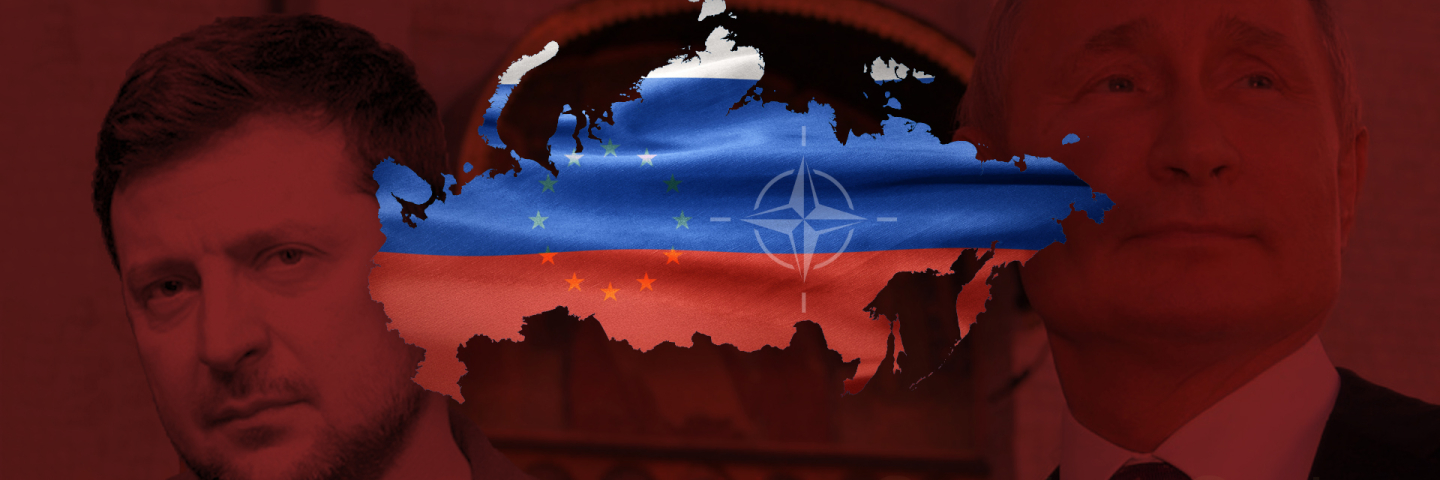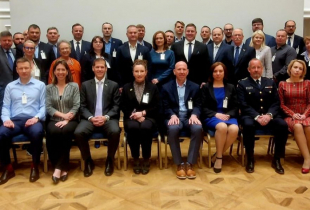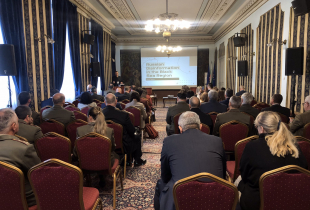
Russia’s End State: Who Will Defend Europe?
This report is a summary of the George C. Marshall European Center for Security Studies (GCMC)’s fourth Strategic Competition Seminar Series (SCSS) virtual seminar for fiscal year 2025 (October 2024 to September 2025). On December 17, 2024, with the Chatham House Rule in operation, 38 individuals, including desk officers from the US Department of Defense, Germany’s Federal Ministry of Defense, GCMC alumni and faculty, other subject matter experts, and Keir Giles discussed Russia’s evolving threat potential and the implications for Europe’s defense. This summary includes insights shared by the presenter and points that emerged from the discussion. It is intended as an aide memoire of the event for the participants and as means of sharing key points and insights with a wider readership.
Introduction
Russia’s 1000-day war of imperial aggression against Ukraine has thus far been contained to Ukraine, in the sense that although Russian subconventional attacks against NATO member states have intensified, conventional military conflict has not spilled over to neighboring states with the opening of an overt second front--horizontal escalation or gone nuclear--vertical escalation. Russia’s field army is tied down in Ukraine, and Putin’s maximalist definition of victory appears to be unachievable for the time being. Nonetheless, Russia’s intent is clear: destroy Ukrainian statehood, and exploit European weaknesses and exacerbate its vulnerabilities. Russia has expanded and restructured its conventional military land forces and has largely preserved its air and naval forces. Moscow has issued nuclear threats and intensified its hybrid attacks. Russia is rearming, remilitarizing, and rebuilding a more Soviet-style semitrained, mass-based force structure--its comfort zone--to prepare for the next war against NATO. Currently, Russian intent is not contested, and there is a broad consensus on the speed at which Russian forces can be reconstituted.
NATO has failed to deter Russia in multiple ways. The Alliance was unable to stop Russia’s conventional invasion of a nonaligned state. NATO has also failed to deter Russia’s hybrid attacks against its own members, and it has allowed Russia’s nuclear threats that seek to impose reflexive control on western decision makers. Indeed, Article 5 seems to have deterred NATO more than it has Russia. [NATO’s period of vulnerability has become Russia’s window of opportunity. Much of NATO currently does not have forces that can suffer prolonged combat attrition, and as such they are not fit for deterrence. The defense intelligence services of NATO allies focus on threat actors and take on trust what allies claim about their capabilities and their defense spending, leading to the risk of substantial gaps between what allies promise to NATO and what they can ultimately deliver when called upon.
Russia’s Conventional Threat Potential
Russia’s military should be judged, ultimately, against its ability to achieve desired outcomes, not its ability to match its own rhetoric with reality. Although the “modernized” battalion tactical group force structure it began the war with in 2022 has been destroyed, by April 2024, Russia’s land army was already 15 percent larger than in February 2022, though the quality was much lower. This is despite record-level Russian military losses, with 30,000 battle casualties a month matching the rate at which new Russian servicemembers are recruited, despite a 15-fold increase in enlistment payments since 2022. The arrival—so far—of a limited contingent of North Korean troops has not as yet made a major impact, but expansion of this contingent should be expected. Russia is unlikely to use nuclear weapons against Ukraine as there are no conceivable scenarios where their use would leave Russia a net beneficiary. Russia may pursue the war until the Russian state itself collapses, but there is still much slack in the system before this occurs.
Western Preparedness
There is a near consensus in NATO among member state chiefs-of-defense staffs, their ministries of defense, service chiefs, and heads of intelligence services that Russia will realistically be positioned to challenge NATO in 3 to 5 years, a remarkable reduction from earlier forecasts of 10 to 20 years. (However, Admiral Tony Radakin, the UK’s current chief of defence staff stated that there is no Russian threat to NATO—an assessment that is an outlier.) How can we account for this?
- First, if an attack on NATO is defined as Russia attacking all of NATO, then this minority assessment holds, but this is a straw man proposition since nobody is suggesting Russia will attack in a manner that would trigger a unified NATO response. Realistically, Russia would use a creeping incremental approach to targeting a single soft ally, at a time when Article 5 itself was under question, in order to bring disunity to the Alliance. Under these circumstances, the classic dilemmas posed by a land grab fait accompli (Russian forces move 30km into a NATO member state then threaten nuclear retaliation if dislodged) apply.
- Second, a more cynical explanation might be that Radakin is under political orders to only declare as threats those that are politically and financially convenient, for example, only those threats the UK government is willing to spend resources on countering. If so, the calculus is that the risk of adjusting government spending to meet actual threats is considered greater than the risk of leaving the UK open to catastrophic defeat through leaving them unaddressed, as, for example, with the UK’s policy that integrated air and missile defence is not required for homeland defense. Similarly, calling acts of war hybrid, grey zone, or liminal threats obviates the need for expensive and politically challenging responses in kind.
Since the end of the Cold War in 1990, Europe has enjoyed its so-called “peace dividend,” reducing its armed forces and defense industries and outsourcing defense to the United States. In other words, the operating assumptions has been that Allies would provide what they promised, and the United States would continue its broad and unconditional commitment to Europe. Thirty years of peace cuts have hollowed out capability, shown up by a proliferation of NATO headquarters without sufficient forces and enablers. Resilience and civil defense of the homeland have been eroded or eliminated altogether, as western European states assumes war happens to others. Ukraine is holding the line for now but cannot protect the West forever.
The US’s “escalation management” approach to Ukraine over the last three years has been predicated on three assumptions:
- First, Ukrainian victory will inevitably mean Russian collapse, civil war, and vertical and horizontal escalation of the conflict.
- Second, a mutually hurting stalemate will lead to negotiations (peace for territory, in other words, European peace for a piece of Ukrainian territory?) and so de-escalation. Under this logic, alternative futures for Ukraine that include Ukraine adopting the South Korean model, are unlikely. In this scenario, a NATO “coalition of the least unwilling” friends of Ukraine offer bilateral security guarantees to West Ukraine, including extended deterrence, or the West German model, where a divided Ukraine is granted NATO membership and with that the Article 5 guarantee. However, both are predicated on the presence of foreign forces in Ukraine that can guarantee its security against future Russian attack, which is not feasible. This leaves equally unlikely scenarios: 1) Ukraine as “Big Israel,” suggesting external guarantees and active defense partnerships (US and NATO coalition of the willing enforcing no-fly zones?), societal resilience, and intelligence dominance; or 2) nuclear Ukraine, as a standalone sovereign option in lieu of meaningful Western commitments or guarantees of Ukraine’s security and an inability otherwise to defend itself or deter future Russian attacks.
- Third, after the war, Russia must be able to reset relations with Euro-Atlantic space and be reintegrated gradually into a European security order, rather than be contained. Russian military-operational defeat in Ukraine is assumed to foreclose reset and reintegration, echoing Russian Foreign Minister Sergey Lavrov’s oft cited mantra: “There can be no European Security without Russia.”
Ukraine’s future strategic options will have implications for a new transatlantic bargain between the United States and Europe. As well as shaping how Russia relates to Europe and so to East and South Asia, it will also impact the United States ability to undertake burden shifting to East Asia to meet the “pacing” and “near peer” threat that is China. In other words, the management of these complex and unpredictable sets of relationships will impact our understanding of the global order paradigm in which we live. After January 20, 2025, President-Elect Donald Trump is likely to accelerate US burden shifting efforts to East Asia and Israel, and could apply the same escalation management logic to European NATO member states that has been applied to Ukraine. This would call into question Article 5 on which NATO unity and collective defense is built as well as whether the defense of Europe remains a core US strategic interest.
Conclusions
The return to power of Trump will accelerate the shifting of US attention and defense resources to Asia Pacific and place stronger obligations on Europe to address security and stability in its own neighborhood. Can Europe make the necessary sacrifices to preserve freedom and prosperity? Can it respond and rebuild its defenses and the create the capabilities necessary to defend a resilient Europe and deter Russia from future attack? The NATO guideline of 2 percent of GDP spent on defense is already outdated as a metric of readiness, and output measures should be urgently agreed upon and enforced instead. The full spectrum comprehensive approach of front-line states, such as Poland, Sweden and Finland, should be standard throughout Europe. Fictional defense expenditure accounting is unacceptable. The UK in real terms currently spends as much on defense (1.7-2.2 percent of GDP depending on accounting) as it did in 1933, as it came out of the Great Depression and spending was at a nadir. Finally, in order to withstand Russia and not fall under its control, Europe needs an independent nuclear tactical and strategic deterrent as a hedge against the United States reconsidering its long-standing principle extended deterrence.
About the Contributors
Mr. Keir Giles has advised governments worldwide on the Russian threat. A senior fellow with Chatham House’s Russia and Eurasia Programme, and Director of the Conflict Studies Research Centre, he is a regular commentator for the BBC and international media. His prescient books include: What Deters Russia; Moscow Rules; and, Who Will Defend Europe? | Hurst Publishers
Dr. Graeme P. Herd is a professor of Transnational Security Studies in the Research and Policy Analysis Department at the George C. Marshall European Center for Security Studies. His latest books include Understanding Russia’s Strategic Behavior: Imperial Strategic Culture and Putin’s Operational Code (London and New York, Routledge, 2022) and Russia’s Global Reach: A Security and Statecraft Assessment, ed. Graeme P. Herd (Garmisch-Partenkirchen: George C. Marshall European Center for Security Studies, 2021).
The George C. Marshall European Center for Security Studies
The George C. Marshall European Center for Security Studies in Garmisch-Partenkirchen, Germany is a German-American partnership and trusted global network promoting common values and advancing collaborative geostrategic solutions. The Marshall Center’s mission to educate, engage, and empower security partners to collectively affect regional, transnational, and global challenges is achieved through programs designed to promote peaceful, whole of government approaches to address today’s most pressing security challenges. Since its creation in 1993, the Marshall Center’s alumni network has grown to include over 16,000 professionals from 160 countries. More information on the Marshall Center can be found online at www.marshallcenter.org.
The Clock Tower Security Series provides short summaries of Seminar Series hosted by the George C. Marshall European Center for Security Studies. These summaries capture key analytical points from the events and serve as a useful tool for policy makers, practitioners, and academics.
Disclaimer:
This summary reflects the views of the authors (Keir Giles and Dr. Graeme P. Herd) and are not necessarily the official policy of the United States, Germany, or any other governments.
GCMC, Garmisch-Partenkirchen, December 18, 2024.

